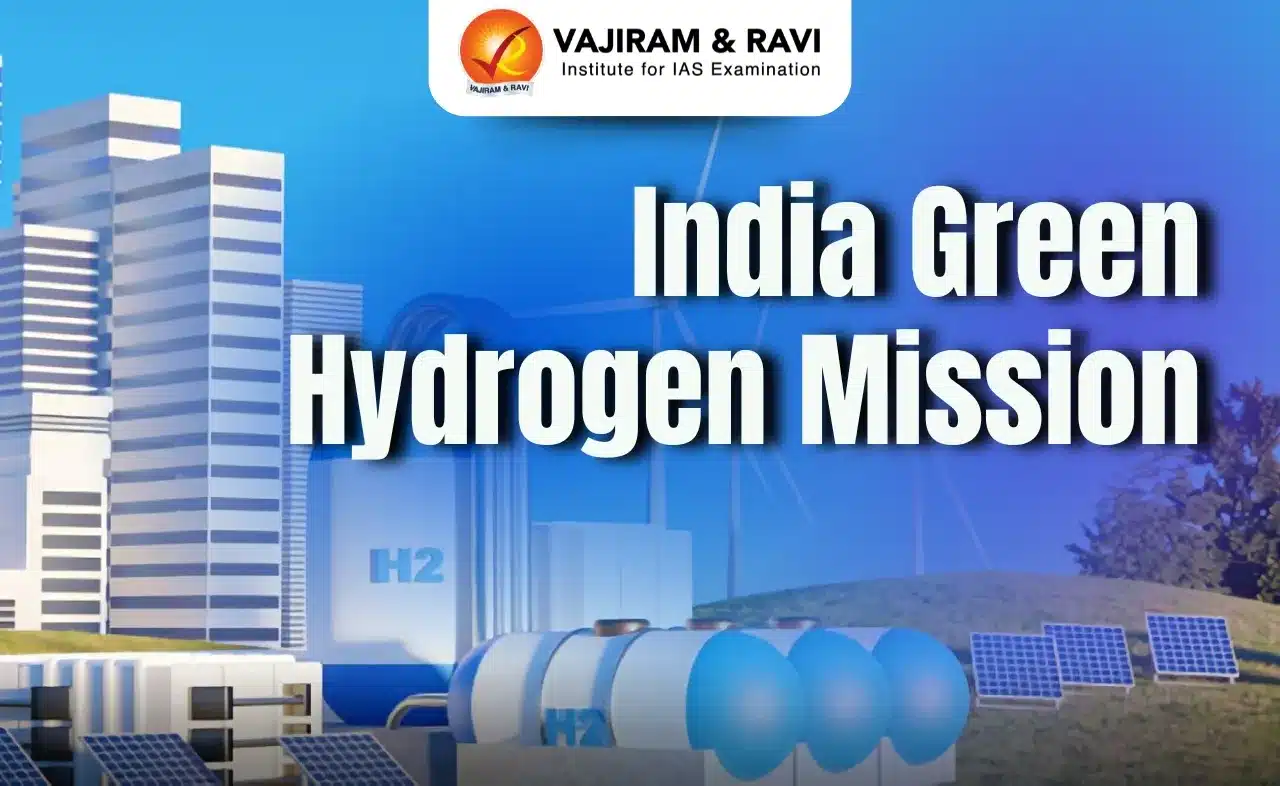Green Hydrogen Sector Latest News
- Stakeholders in India’s emerging green hydrogen sector remain optimistic that the alternative fuel is poised to play a significant role in the country’s future energy landscape.
Domestic Push to Green Hydrogen Development
- India’s green hydrogen sector is at a pivotal juncture. With global demand faltering due to geopolitical tensions and uncertain international policy environments, India has turned its attention inward, focusing on domestic demand creation, infrastructure, and policy support.
- The government and industry remain confident in the long-term prospects of green hydrogen, recognising its potential role in decarbonising key sectors like fertilisers, steel, and shipping.
National Green Hydrogen Mission and Strategic Interventions
- Launched in 2023, the National Green Hydrogen Mission is India’s flagship initiative to position the country as a global hub for green hydrogen production, usage, and export.
- Backed by an outlay of Rs 19,744 crore, the mission aims to develop 5 million metric tonnes (MMT) of green hydrogen production capacity by 2030.
- It also includes provisions for the domestic manufacture of electrolysers under the SIGHT (Strategic Interventions for Green Hydrogen Transition) programme.
- To ensure integrity and transparency, the Ministry of New and Renewable Energy (MNRE) introduced a measurement and certification framework in April 2025, establishing standards to verify green hydrogen at production sites.
Global Headwinds Affect Export Demand
- Despite significant investments and plans for export-oriented projects like ReNew’s green ammonia facility in Odisha, India’s export aspirations face severe constraints.
- At the heart of the slowdown is the weakening of global demand, a consequence of both geopolitical instability and policy uncertainty in key markets like the US and EU.
- MNRE highlighted that lack of market visibility and setbacks to US policies such as the Inflation Reduction Act (IRA), now threatened by a rollback proposal called the “Big Beautiful Bill” under consideration by the US Senate, have undermined investor confidence and planning in global clean fuel transitions.
- Additionally, tenders floated by European agencies such as Germany’s Hintco (under the H2Global Foundation) failed to attract sufficient industry participation, compounding the export sluggishness.
Efforts to Secure Global Access
- To address logistical and trade-related barriers, India is engaging with major European ports, including Rotterdam and Antwerp, to streamline future green hydrogen shipments.
- At the policy level, free trade agreement (FTA) discussions with Europe now include proposals to reduce import duties on Indian green hydrogen and derivatives.
- Nonetheless, the short-term outlook for exports remains bleak, pushing stakeholders to explore alternative paths for sectoral growth.
Domestic Demand as a Growth Driver
- In response, the Indian government is aggressively working to build a robust domestic market for green hydrogen.
- A recent tender for the supply of 8 lakh tonnes of green hydrogen received full bids, demonstrating rising interest among Indian enterprises.
- Additionally, the Solar Energy Corporation of India (SECI) is managing another tender for 7 lakh tonnes, particularly aimed at the fertiliser industry.
- To further ensure offtake, pilot initiatives are being rolled out in sectors like transportation, steel, and shipping. Hydrogen fuel cell buses are currently being tested in five cities, including Ladakh, to examine real-world performance.
- Industry voices have argued that domestic mandates may be necessary to truly scale adoption, for example, making it mandatory for fertiliser manufacturers to source a portion of their ammonia from green hydrogen sources.
Cost Competitiveness and Commercial Viability
- The greatest hurdle to mainstream adoption remains cost competitiveness.
- Currently, green hydrogen costs $4-$5 per kg, compared to $2.3-$2.5 per kg for grey hydrogen, which is produced using fossil fuels.
- These cost dynamics mean that, unlike renewables today, green hydrogen is not yet commercially viable without policy mandates or incentives.
- A new report by CII, Bain & Company, and RMI attributes this high cost to immature supply chains, high financing costs, and lack of scale. It recommends incremental strategies to boost demand, including:
- Blending green hydrogen into grey hydrogen or piped natural gas networks.
- Encouraging its use in niche sectors such as ceramics, chemicals, and glass.
- Leveraging public procurement, particularly for green steel, to boost scale and lower costs.
Future Outlook: Balancing Export Aspirations and Domestic Realities
- India’s long-term vision for green hydrogen remains ambitious and well-supported.
- However, present challenges suggest a need to rebalance expectations, shifting emphasis from export-oriented growth to domestic market creation and infrastructure building.
- If successful, India could replicate its renewables success story in this domain too, gradually achieving cost parity and becoming a leader in global green hydrogen trade.
Last updated on January, 2026
→ Check out the latest UPSC Syllabus 2026 here.
→ Join Vajiram & Ravi’s Interview Guidance Programme for expert help to crack your final UPSC stage.
→ UPSC Mains Result 2025 is now out.
→ UPSC Notification 2026 is scheduled to be released on January 14, 2026.
→ UPSC Calendar 2026 is released on 15th May, 2025.
→ UPSC Prelims 2026 will be conducted on 24th May, 2026 & UPSC Mains 2026 will be conducted on 21st August 2026.
→ The UPSC Selection Process is of 3 stages-Prelims, Mains and Interview.
→ UPSC Result 2024 is released with latest UPSC Marksheet 2024. Check Now!
→ UPSC Toppers List 2024 is released now. Shakti Dubey is UPSC AIR 1 2024 Topper.
→ Also check Best IAS Coaching in Delhi
Green Hydrogen Sector FAQs
Q1. What is the National Green Hydrogen Mission?+
Q2. Why is India facing challenges in green hydrogen exports?+
Q3. What measures is the Indian government taking to boost domestic demand?+
Q4. Why is green hydrogen not yet commercially viable?+
Q5. How is green hydrogen used across sectors?+
Tags: green hydrogen sector mains articles upsc current affairs upsc mains current affairs

















